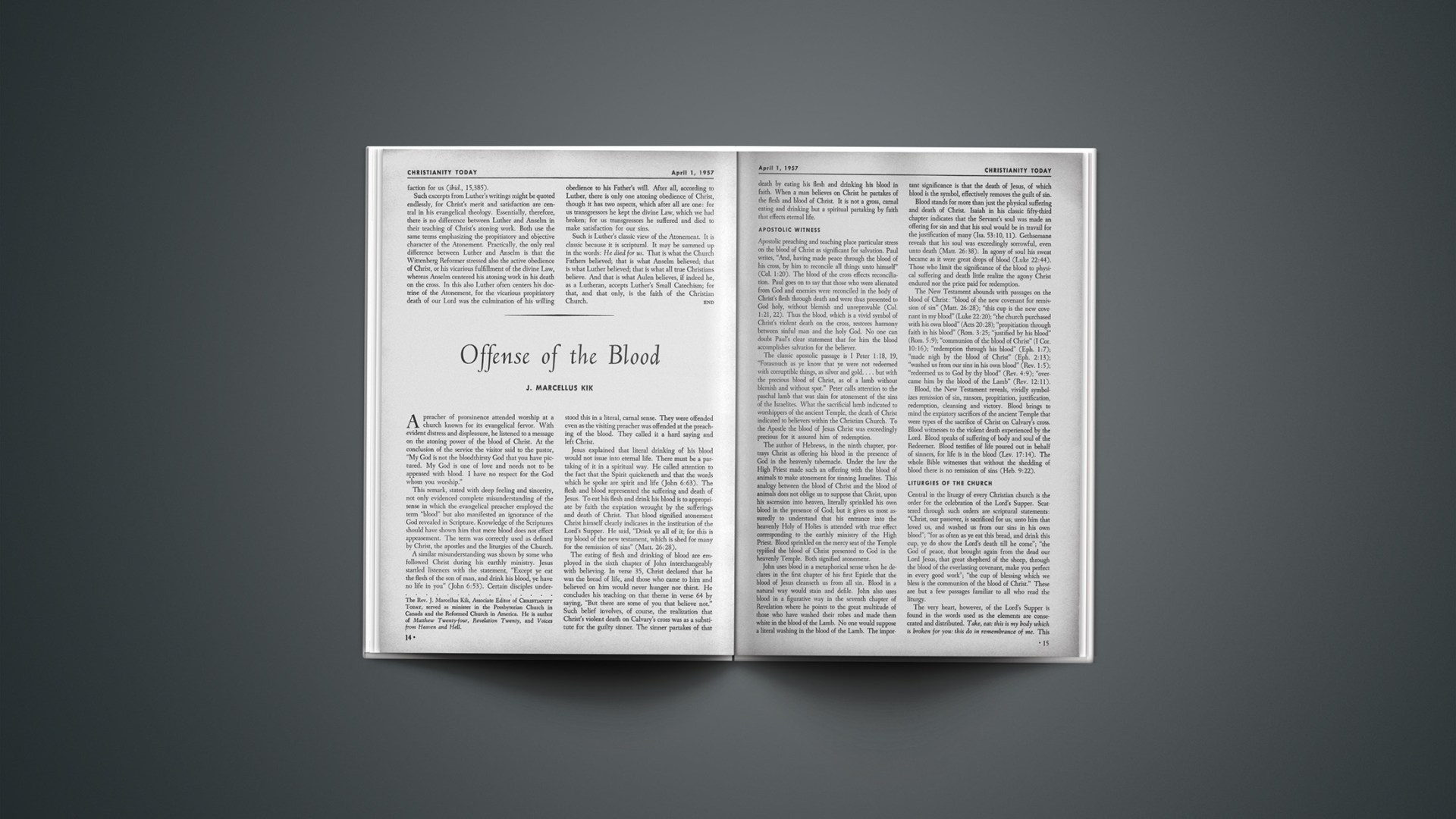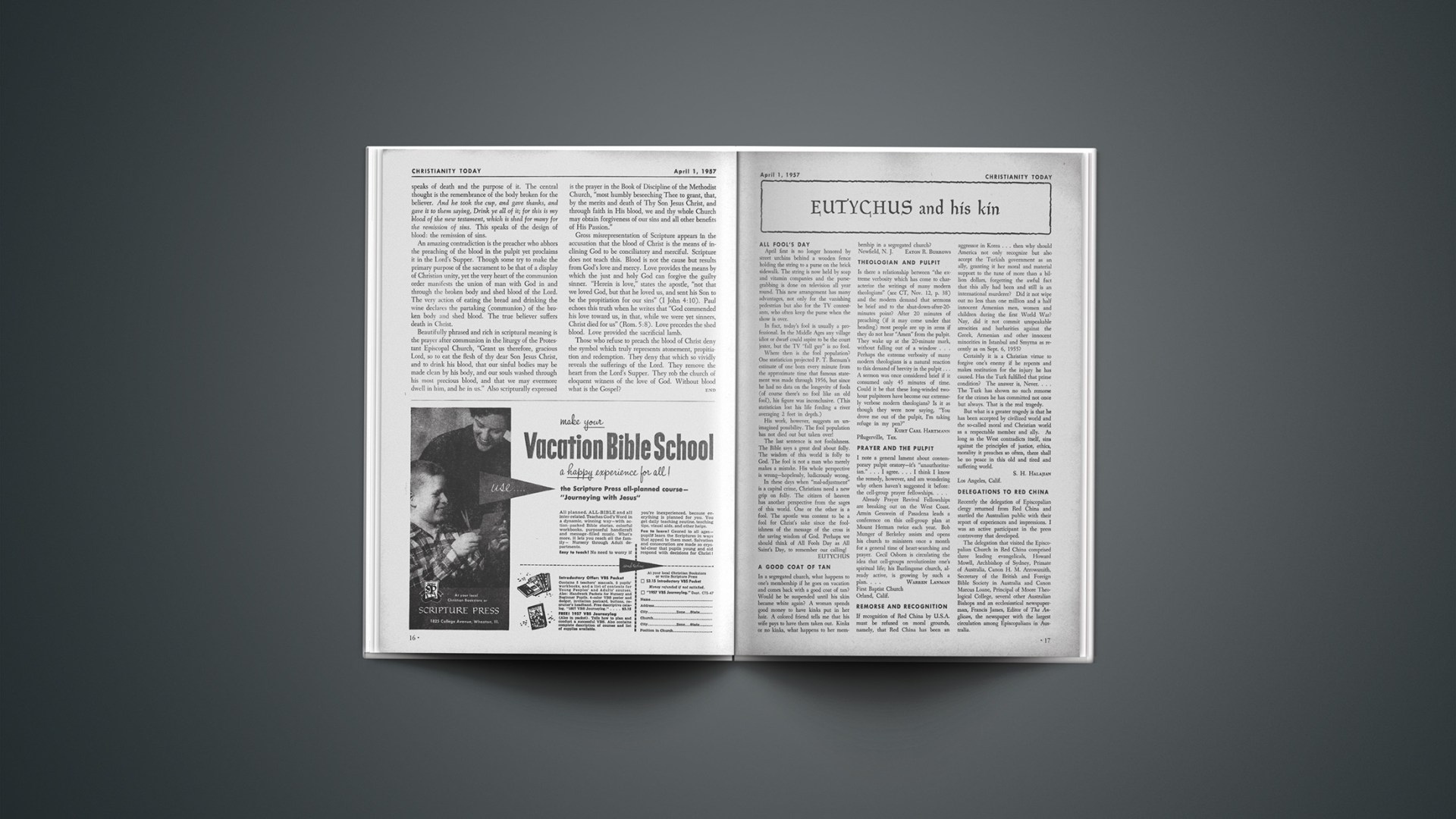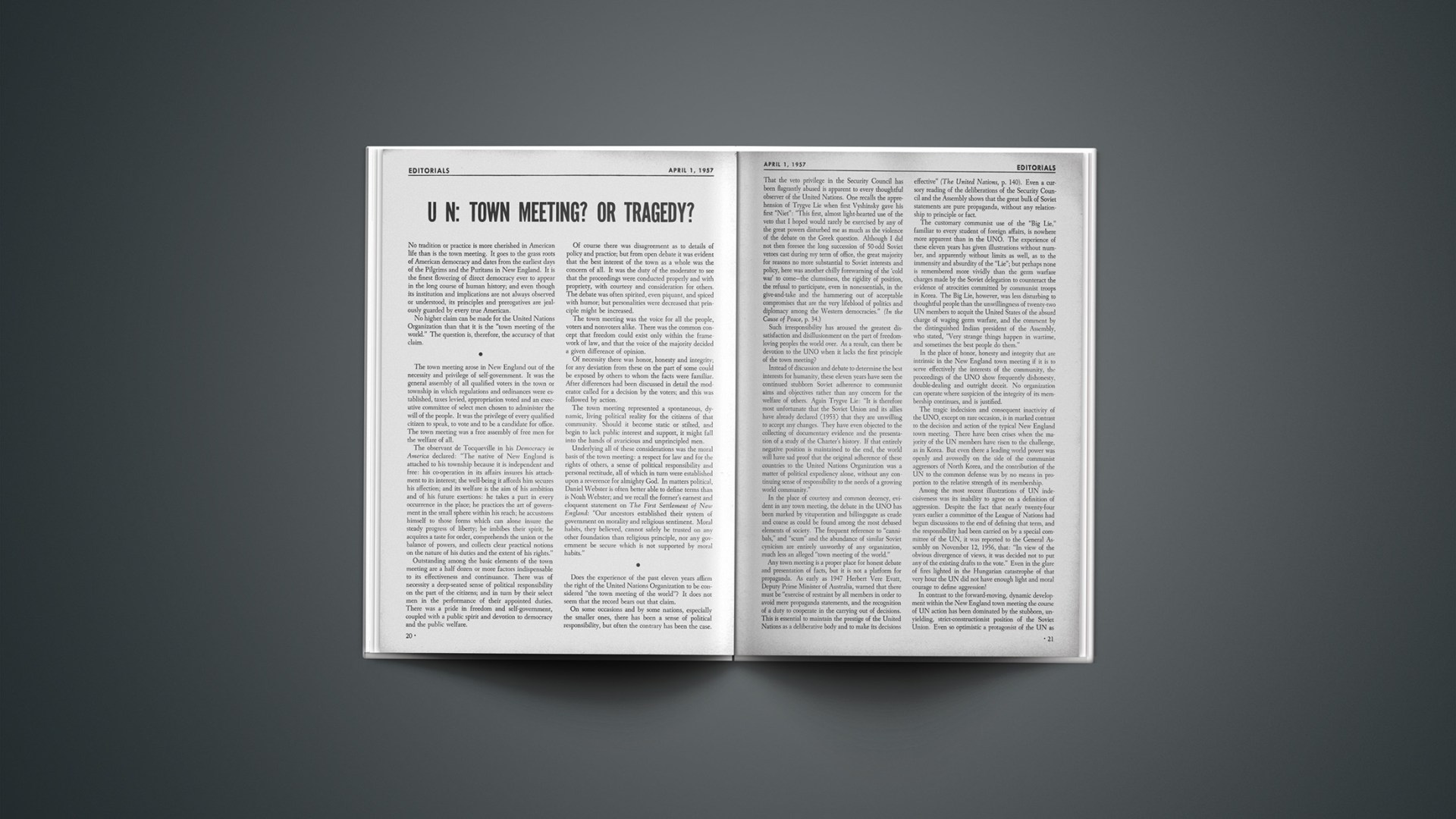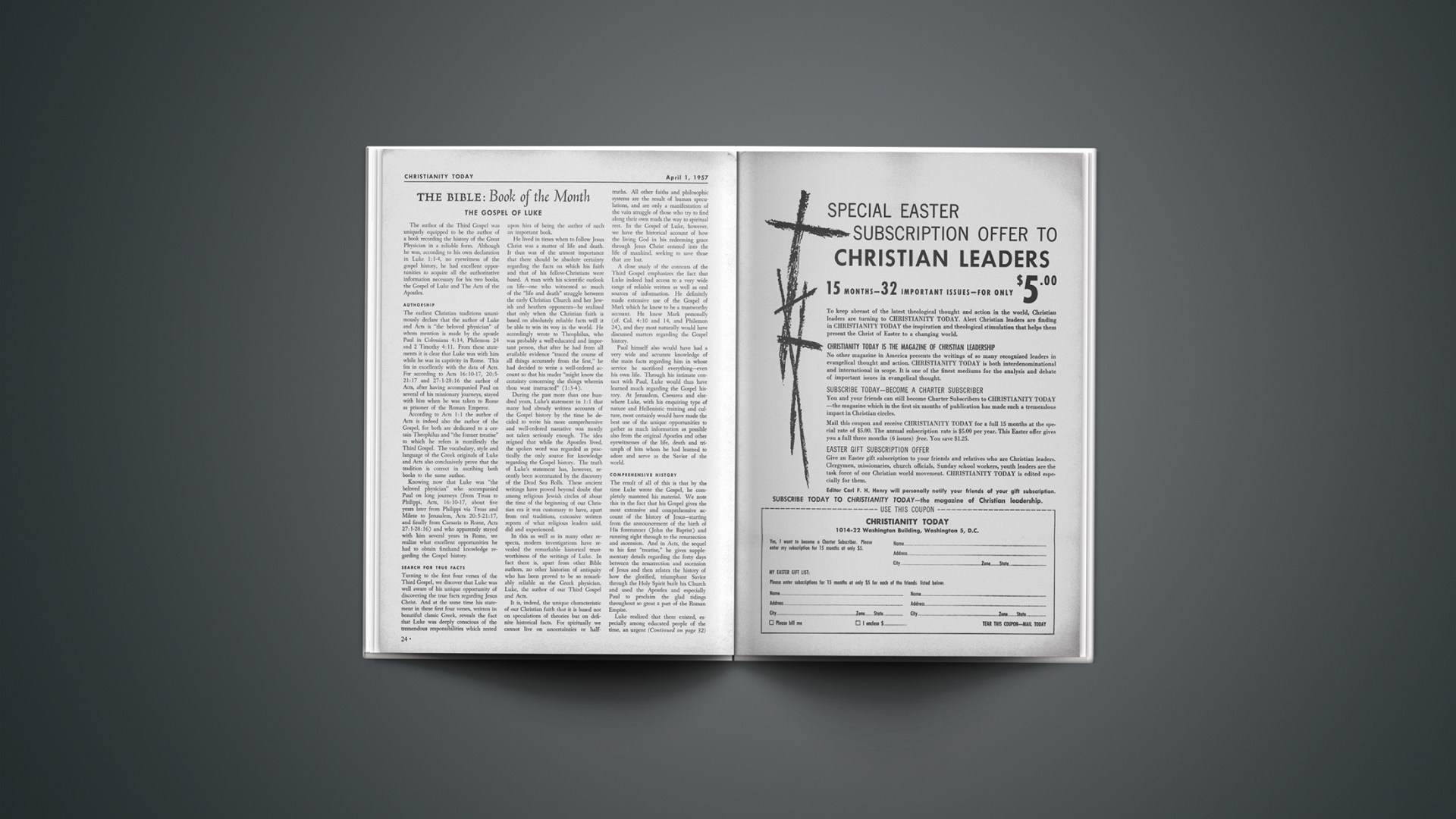A preacher of prominence attended worship at a church known for its evangelical fervor. With evident distress and displeasure, he listened to a message on the atoning power of the blood of Christ. At the conclusion of the service the visitor said to the pastor, “My God is not the bloodthirsty God that you have pictured. My God is one of love and needs not to be appeased with blood. I have no respect for the God whom you worship.”
This remark, stated with deep feeling and sincerity, not only evidenced complete misunderstanding of the sense in which the evangelical preacher employed the term “blood” but also manifested an ignorance of the God revealed in Scripture. Knowledge of the Scriptures should have shown him that mere blood does not effect appeasement. The term was correctly used as defined by Christ, the apostles and the liturgies of the Church.
A similar misunderstanding was shown by some who followed Christ during his earthly ministry. Jesus startled listeners with the statement, “Except ye eat the flesh of the son of man, and drink his blood, ye have no life in you” (John 6:53). Certain disciples understood this in a literal, carnal sense. They were offended even as the visiting preacher was offended at the preaching of the blood. They called it a hard saying and left Christ.
Jesus explained that literal drinking of his blood would not issue into eternal life. There must be a partaking of it in a spiritual way. He called attention to the fact that the Spirit quickeneth and that the words which he spoke are spirit and life (John 6:63). The flesh and blood represented the suffering and death of Jesus. To eat his flesh and drink his blood is to appropriate by faith the expiation wrought by the sufferings and death of Christ. That blood signified atonement Christ himself clearly indicates in the institution of the Lord’s Supper. He said, “Drink ye all of it; for this is my blood of the new testament, which is shed for many for the remission of sins” (Matt. 26:28).
The eating of flesh and drinking of blood are employed in the sixth chapter of John interchangeably with believing. In verse 35, Christ declared that he was the bread of life, and those who came to him and believed on him would never hunger nor thirst. He concludes his teaching on that theme in verse 64 by saying, “But there are some of you that believe not.” Such belief involves, of course, the realization that Christ’s violent death on Calvary’s cross was as a substitute for the guilty sinner. The sinner partakes of that death by eating his flesh and drinking his blood in faith. When a man believes on Christ he partakes of the flesh and blood of Christ. It is not a gross, carnal eating and drinking but a spiritual partaking by faith that effects eternal life.
Apostolic Witness
Apostolic preaching and teaching place particular stress on the blood of Christ as significant for salvation. Paul writes, “And, having made peace through the blood of his cross, by him to reconcile all things unto himself” (Col. 1:20). The blood of the cross effects reconciliation. Paul goes on to say that those who were alienated from God and enemies were reconciled in the body of Christ’s flesh through death and were thus presented to God holy, without blemish and unreprovable (Col. 1:21, 22). Thus the blood, which is a vivid symbol of Christ’s violent death on the cross, restores harmony between sinful man and the holy God. No one can doubt Paul’s clear statement that for him the blood accomplishes salvation for the believer.
The classic apostolic passage is 1 Peter 1:18, 19, “Forasmuch as ye know that ye were not redeemed with corruptible things, as silver and gold.… but with the precious blood of Christ, as of a lamb without blemish and without spot.” Peter calls attention to the paschal lamb that was slain for atonement of the sins of the Israelites. What the sacrificial lamb indicated to worshippers of the ancient Temple, the death of Christ indicated to believers within the Christian Church. To the Apostle the blood of Jesus Christ was exceedingly precious for it assured him of redemption.
The author of Hebrews, in the ninth chapter, portrays Christ as offering his blood in the presence of God in the heavenly tabernacle. Under the law the High Priest made such an offering with the blood of animals to make atonement for sinning Israelites. This analogy between the blood of Christ and the blood of animals does not oblige us to suppose that Christ, upon his ascension into heaven, literally sprinkled his own blood in the presence of God; but it gives us most assuredly to understand that his entrance into the heavenly Holy of Holies is attended with true effect corresponding to the earthly ministry of the High Priest. Blood sprinkled on the mercy seat of the Temple typified the blood of Christ presented to God in the heavenly Temple. Both signified atonement.
John uses blood in a metaphorical sense when he declares in the first chapter of his first Epistle that the blood of Jesus cleanseth us from all sin. Blood in a natural way would stain and defile. John also uses blood in a figurative way in the seventh chapter of Revelation where he points to the great multitude of those who have washed their robes and made them white in the blood of the Lamb. No one would suppose a literal washing in the blood of the Lamb. The important significance is that the death of Jesus, of which blood is the symbol, effectively removes the guilt of sin.
Blood stands for more than just the physical suffering and death of Christ. Isaiah in his classic fifty-third chapter indicates that the Servant’s soul was made an offering for sin and that his soul would be in travail for the justification of many (Isa. 53:10, 11). Gethsemane reveals that his soul was exceedingly sorrowful, even unto death (Matt. 26:38). In agony of soul his sweat became as it were great drops of blood (Luke 22:44). Those who limit the significance of the blood to physical suffering and death little realize the agony Christ endured nor the price paid for redemption.
The New Testament abounds with passages on the blood of Christ: “blood of the new covenant for remission of sin” (Matt. 26:28); “this cup is the new covenant in my blood” (Luke 22:20); “the church purchased with his own blood” (Acts 20:28); “propitiation through faith in his blood” (Rom. 3:25; “justified by his blood” (Rom. 5:9); “communion of the blood of Christ” (1 Cor. 10:16); “redemption through his blood” (Eph. 1:7); “made nigh by the blood of Christ” (Eph. 2:13); “washed us from our sins in his own blood” (Rev. 1:5); “redeemed us to God by thy blood” (Rev. 4:9); “overcame him by the blood of the Lamb” (Rev. 12:11).
Blood, the New Testament reveals, vividly symbolizes remission of sin, ransom, propitiation, justification, redemption, cleansing and victory. Blood brings to mind the expiatory sacrifices of the ancient Temple that were types of the sacrifice of Christ on Calvary’s cross. Blood witnesses to the violent death experienced by the Lord. Blood speaks of suffering of body and soul of the Redeemer. Blood testifies of life poured out in behalf of sinners, for life is in the blood (Lev. 17:14). The whole Bible witnesses that without the shedding of blood there is no remission of sins (Heb. 9:22).
Liturgies Of The Church
Central in the liturgy of every Christian church is the order for the celebration of the Lord’s Supper. Scattered through such orders are scriptural statements: “Christ, our passover, is sacrificed for us; unto him that loved us, and washed us from our sins in his own blood”; “for as often as ye eat this bread, and drink this cup, ye do show the Lord’s death till he come”; “the God of peace, that brought again from the dead our Lord Jesus, that great shepherd of the sheep, through the blood of the everlasting covenant, make you perfect in every good work”; “the cup of blessing which we bless is the communion of the blood of Christ.” These are but a few passages familiar to all who read the liturgy.
The very heart, however, of the Lord’s Supper is found in the words used as the elements are consecrated and distributed. Take, eat: this is my body which is broken for you: this do in remembrance of me. This speaks of death and the purpose of it. The central thought is the remembrance of the body broken for the believer. And he took the cup, and gave thanks, and gave it to them saying, Drink ye all of it; for this is my blood of the new testament, which is shed for many for the remission of sins. This speaks of the design of blood: the remission of sins.
An amazing contradiction is the preacher who abhors the preaching of the blood in the pulpit yet proclaims it in the Lord’s Supper. Though some try to make the primary purpose of the sacrament to be that of a display of Christian unity, yet the very heart of the communion order manifests the union of man with God in and through the broken body and shed blood of the Lord. The very action of eating the bread and drinking the wine declares the partaking (communion) of the broken body and shed blood. The true believer suffers death in Christ.
Beautifully phrased and rich in scriptural meaning is the prayer after communion in the liturgy of the Protestant Episcopal Church, “Grant us therefore, gracious Lord, so to eat the flesh of thy dear Son Jesus Christ, and to drink his blood, that our sinful bodies may be made clean by his body, and our souls washed through his most precious blood, and that we may evermore dwell in him, and he in us.” Also scripturally expressed is the prayer in the Book of Discipline of the Methodist Church, “most humbly beseeching Thee to grant, that, by the merits and death of Thy Son Jesus Christ, and through faith in His blood, we and thy whole Church may obtain forgiveness of our sins and all other benefits of His Passion.”
Gross misrepresentation of Scripture appears in the accusation that the blood of Christ is the means of inclining God to be conciliatory and merciful. Scripture does not teach this. Blood is not the cause but results from God’s love and mercy. Love provides the means by which the just and holy God can forgive the guilty sinner. “Herein is love,” states the apostle, “not that we loved God, but that he loved us, and sent his Son to be the propitiation for our sins” (1 John 4:10). Paul echoes this truth when he writes that “God commended his love toward us, in that, while we were yet sinners, Christ died for us” (Rom. 5:8). Love precedes the shed blood. Love provided the sacrificial lamb.
Those who refuse to preach the blood of Christ deny the symbol which truly represents atonement, propitiation and redemption. They deny that which so vividly reveals the sufferings of the Lord. They remove the heart from the Lord’s Supper. They rob the church of eloquent witness of the love of God. Without blood what is the Gospel?
For a generation, since 1921, J. Theodore Mueller has served Concordia Seminary, St. Louis, as Professor of Systematic Theology and Exegesis. Although he nears his 72nd birthday, his teaching career is not yet over, and he continues on modified faculty service.











